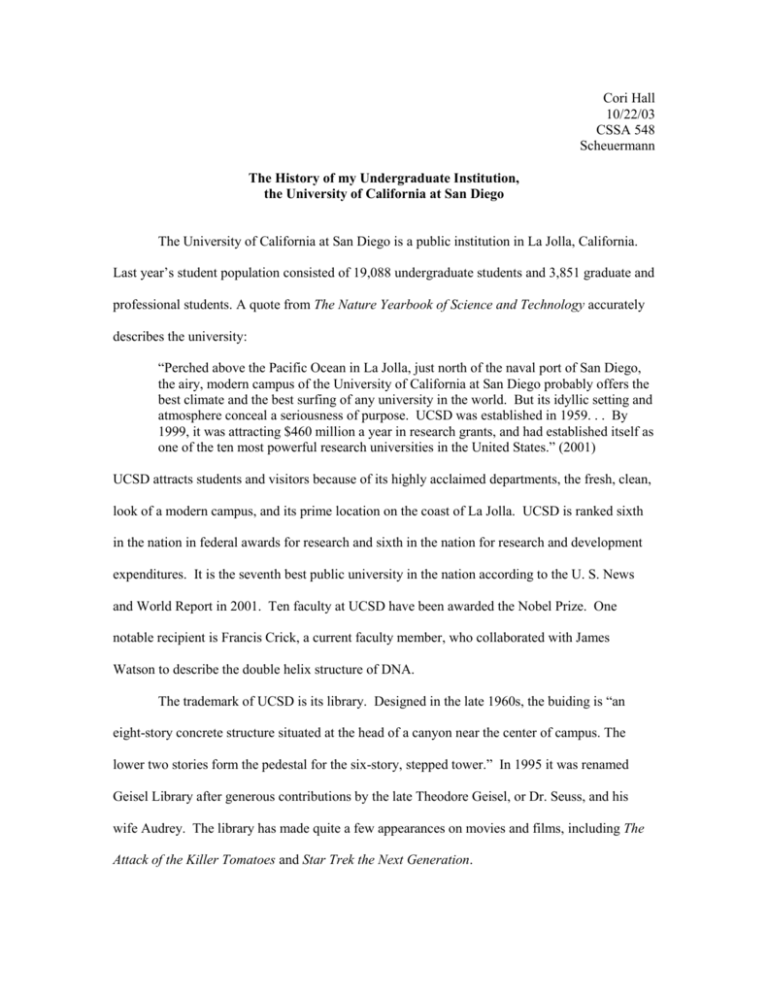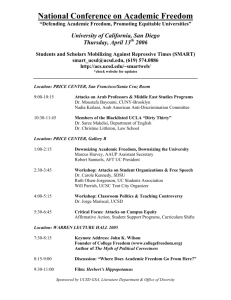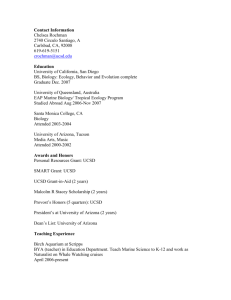History of my Undergraduate Institution
advertisement

Cori Hall 10/22/03 CSSA 548 Scheuermann The History of my Undergraduate Institution, the University of California at San Diego The University of California at San Diego is a public institution in La Jolla, California. Last year’s student population consisted of 19,088 undergraduate students and 3,851 graduate and professional students. A quote from The Nature Yearbook of Science and Technology accurately describes the university: “Perched above the Pacific Ocean in La Jolla, just north of the naval port of San Diego, the airy, modern campus of the University of California at San Diego probably offers the best climate and the best surfing of any university in the world. But its idyllic setting and atmosphere conceal a seriousness of purpose. UCSD was established in 1959. . . By 1999, it was attracting $460 million a year in research grants, and had established itself as one of the ten most powerful research universities in the United States.” (2001) UCSD attracts students and visitors because of its highly acclaimed departments, the fresh, clean, look of a modern campus, and its prime location on the coast of La Jolla. UCSD is ranked sixth in the nation in federal awards for research and sixth in the nation for research and development expenditures. It is the seventh best public university in the nation according to the U. S. News and World Report in 2001. Ten faculty at UCSD have been awarded the Nobel Prize. One notable recipient is Francis Crick, a current faculty member, who collaborated with James Watson to describe the double helix structure of DNA. The trademark of UCSD is its library. Designed in the late 1960s, the buiding is “an eight-story concrete structure situated at the head of a canyon near the center of campus. The lower two stories form the pedestal for the six-story, stepped tower.” In 1995 it was renamed Geisel Library after generous contributions by the late Theodore Geisel, or Dr. Seuss, and his wife Audrey. The library has made quite a few appearances on movies and films, including The Attack of the Killer Tomatoes and Star Trek the Next Generation. The undergraduate program at UCSD is different from most universities. It is a system of six residential colleges, which each have a distinct intellectual theme and set of general education requirements which complement this theme. Each college houses its own residential community, dean of students office, and advising office. At Earl Warren College, the mission of the college and the general education requirements are based on the ideas of citizenship, individual responsibilities, informed judgement, and awareness on issues. Two of the curricular requirements are a class in cultural diversity and an ethics class. The student can feel at home in the college while still experiencing all that the larger university has to offer. The origins of UCSD were with the founding of Scripps Institution of Oceanography. In the late 19th century, a group of zoologists from the University of California at Berkeley established a marine research station in La Jolla. The Scripps family donated a section of land and a building which were deeded to the Regents of the University of California in 1912. This institution is now the center of most of the oceanographic research and instruction in the world. The threat of the Cold War in the mid 1950’s initiated the need of scientific education and research in the United States. In response to this and high interest in the San Diego community, the Board of Regents began planning for an additional UC campus adjacent to Scripps. In 1958 Roger Revelle, the director of Scripps, was selected to head the new faculty. The first graduate students were enrolled in the school of Science and Engineering at the UCSD in 1960. The first undergraduate class was enrolled in 1964. With the expansion of the university’s programs in humanities and social sciences, the school became the First College in 1963, and finally renamed Revelle College in 1965. By this time the structures of UCSD consisted of Revelle College’s plaza surrounded by six major classrooms and laboratory buildings. Since UCSD’s founding, it has been in a constant process of expansion of programs and construction of new buildings. John Muir College accepted its first students in the fall of 1967. The medical school opened in 1968. Thurgood Marshall College and Earl Warren College opened enrollment in 1970 and 1974 respectively. Eleanor Roosevelt College (ERC) began in 1988. In 2002 ERC’s new facilities opened, and the sixth college and the pharmacy school enrolled their pioneering classes. By the year of 2010, UCSD is projected to reach its capacity at 30,000 students. Strategic planning committees are all ready in full force in order to handle the yearly increases in students. “Innovation is our tradition,” as stated by the UCSD website. If this tradition carries out through the next decade, the university will continue to attract high quality students as it does today. References As Others See UCSD Retrieved October 20, 2003 from http://ucsdnews.ucsd.edu/publications/othersee.htm UC San Diego – A Historical Overview Retrieved October 20, 2003 from http://sunsite.berkeley.edu/uchistory/general_history/campuses/ucsd/overview.html Earl Warren College – College History Retrieved on October 17, 2003 from http://warren.ucsd.edu/history.html UCSD Strategic Plan 2002-2007 Retrieved on October 20, 2003 from http://www.vcsa.ucsd.edu/strategicplan.pdf UCSD Student Data Summary Retrieved October 20, 2003 from http://ugr8.ucsd.edu/sriweb/profile2002.pdf UCSD Visitors and Friends – Who We Are Retrieved October 20, 2003 from http://www-er.ucsd.edu/who/index.htm





